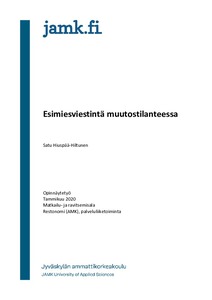Esimiesviestintä muutostilanteessa
Hiuspää-Hiltunen, Satu (2020)
Hiuspää-Hiltunen, Satu
2020
All rights reserved. This publication is copyrighted. You may download, display and print it for Your own personal use. Commercial use is prohibited.
Julkaisun pysyvä osoite on
https://urn.fi/URN:NBN:fi:amk-202002182568
https://urn.fi/URN:NBN:fi:amk-202002182568
Tiivistelmä
Tiivistelmä
Toimeksiantajan uuden johdon tavoitteena oli selvittää henkilöstön kokemuksia esimiesviestinnästä vastaanoton muutosprosessissa. Tavoitteena oli kuulla henkilöstön näkemyksiä esimiesviestinnän toimivuudesta muutoksen ympärillä ja tunnistaa kehitystarpeita esimiesviestinnässä.
Tutkimus toteutettiin kesällä 2019 laadullisesti kahdessa vaiheessa. Ensimmäisessä vaiheessa esimiesviestintää tutkittiin havainnoimalla työympäristöä kahden kuukauden ajan. Lisäksi aineistoa kerättiin mm. henkilöstön lokikirjasta, viikkopalavereiden muistioista sekä henkilöstön ja johdon kertomuksista. Osallistuvan havainnoinnin aikana kartoitettiin kohderyhmää, ilmiötä ja luotiin luottamussuhdetta henkilöstöön. Tutkimuksen toisessa vaiheessa aineistoa kerättiin teemahaastattelemalla muutoksessa mukana olleita kahdeksaa vastaanotossa työskentelevää työntekijää. Tutkimusaineisto analysoitiin teemoittamalla.
Tutkimustulosten perusteella voidaan sanoa, että vastaanoton muutos oli toivottu. Henkilöstö uskoi muutoksen tehostaneen positiivisesti asiakaspalvelua ja työntekoa. Muutoksen esimiesviestintä koettiin osittain toimivaksi. Henkilöstön näkemyksen mukaan haasteelliseksi koettiin muutoksen aikataulusta sekä perehdytyksestä annettu viestinnän vähäinen määrä. Osallistaminen muutoksessa koettiin pääosin hyvin toteutetuksi. Henkilöstön edustajien mukaan heidän mielipiteitään kuunneltiin ja annettiin mahdollisuus osallistua omien toiveiden mukaan.
Ihmiset, työkulttuurin ja tunteet huomioiva kaksisuuntainen muutosviestintä lisää motivaatiota muutosta kohtaan. Esimiehen strateginen ja johdonmukainen toiminta vahvistaa turvallisuuden tunnetta. Johdon tunneäly lisää työhyvinvointia muutoksessa. The aim of the new management at the Summassaari Spa Hotel was to investigate the staff's experience of managerial communication in the process of changing the reception. The objective was to study the viewpoints of the staff on how managerial communication worked in change and to recognize areas of development in managerial communication.
The study was conducted as a qualitative study in two phases in 2019. In the first phase, managerial communication was studied by observing the working environment for two months. The material was also collected from staff log, weekly meeting memos, and staff and management reports. During participant observation, the target group and the phenomenon was examined, and a relationship of trust was established with the personnel. In the second phase, the material was collected by theme interviewing eight reception staff members who were involved in the change. The research material was analyzed by theme.
Based on the results of the study, it can be said that the change in the reception was desirable. The personnel believed that the change had a positive effect on customer service and work. The managerial communication of the change was considered partially functional. According to the staff, the scarce communication about the schedule for the change and introduction was considered challenging. The involvement of the staff in the change process was thought to be mainly well implemented. As to the staff, their opinions were listened to and they were given the chance to participate in the change as they wished.
Two-way change communication that takes people, work culture and emotions into account increases motivation regarding the change. The manager’s strategic activity and consistency strengthens the feeling of security. Emotional intelligence of the management improves well-being in the process of change.
Toimeksiantajan uuden johdon tavoitteena oli selvittää henkilöstön kokemuksia esimiesviestinnästä vastaanoton muutosprosessissa. Tavoitteena oli kuulla henkilöstön näkemyksiä esimiesviestinnän toimivuudesta muutoksen ympärillä ja tunnistaa kehitystarpeita esimiesviestinnässä.
Tutkimus toteutettiin kesällä 2019 laadullisesti kahdessa vaiheessa. Ensimmäisessä vaiheessa esimiesviestintää tutkittiin havainnoimalla työympäristöä kahden kuukauden ajan. Lisäksi aineistoa kerättiin mm. henkilöstön lokikirjasta, viikkopalavereiden muistioista sekä henkilöstön ja johdon kertomuksista. Osallistuvan havainnoinnin aikana kartoitettiin kohderyhmää, ilmiötä ja luotiin luottamussuhdetta henkilöstöön. Tutkimuksen toisessa vaiheessa aineistoa kerättiin teemahaastattelemalla muutoksessa mukana olleita kahdeksaa vastaanotossa työskentelevää työntekijää. Tutkimusaineisto analysoitiin teemoittamalla.
Tutkimustulosten perusteella voidaan sanoa, että vastaanoton muutos oli toivottu. Henkilöstö uskoi muutoksen tehostaneen positiivisesti asiakaspalvelua ja työntekoa. Muutoksen esimiesviestintä koettiin osittain toimivaksi. Henkilöstön näkemyksen mukaan haasteelliseksi koettiin muutoksen aikataulusta sekä perehdytyksestä annettu viestinnän vähäinen määrä. Osallistaminen muutoksessa koettiin pääosin hyvin toteutetuksi. Henkilöstön edustajien mukaan heidän mielipiteitään kuunneltiin ja annettiin mahdollisuus osallistua omien toiveiden mukaan.
Ihmiset, työkulttuurin ja tunteet huomioiva kaksisuuntainen muutosviestintä lisää motivaatiota muutosta kohtaan. Esimiehen strateginen ja johdonmukainen toiminta vahvistaa turvallisuuden tunnetta. Johdon tunneäly lisää työhyvinvointia muutoksessa.
The study was conducted as a qualitative study in two phases in 2019. In the first phase, managerial communication was studied by observing the working environment for two months. The material was also collected from staff log, weekly meeting memos, and staff and management reports. During participant observation, the target group and the phenomenon was examined, and a relationship of trust was established with the personnel. In the second phase, the material was collected by theme interviewing eight reception staff members who were involved in the change. The research material was analyzed by theme.
Based on the results of the study, it can be said that the change in the reception was desirable. The personnel believed that the change had a positive effect on customer service and work. The managerial communication of the change was considered partially functional. According to the staff, the scarce communication about the schedule for the change and introduction was considered challenging. The involvement of the staff in the change process was thought to be mainly well implemented. As to the staff, their opinions were listened to and they were given the chance to participate in the change as they wished.
Two-way change communication that takes people, work culture and emotions into account increases motivation regarding the change. The manager’s strategic activity and consistency strengthens the feeling of security. Emotional intelligence of the management improves well-being in the process of change.
